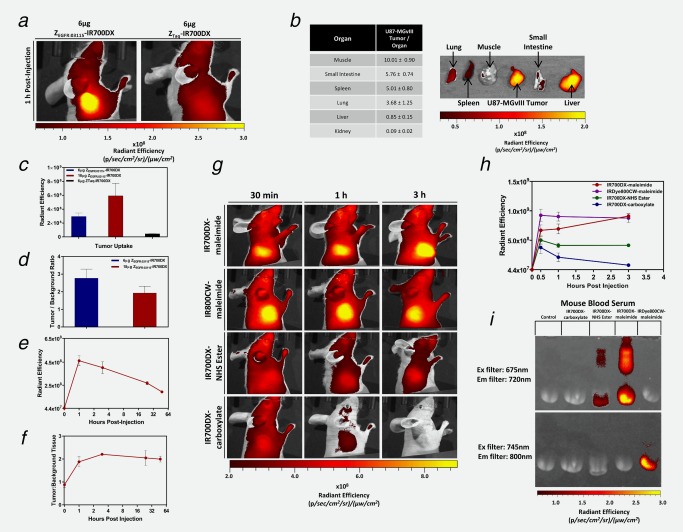Figure 4.

Testing ZEGFR:03115–IR700DX specificity in vivo and studying the effect of functional groups on dye pharmacokinetics. (a) The U87‐MGvIII tumor could easily be differentiated as early as 1 h post ZEGFR:03115–IR700DX (6 µg/mouse) being intravenously injected, whereas minimal tumor uptake was observed when administering the same amount of the non‐specific ZTaq‐IR700DX. (b) Fluorescence imaging of ZEGFR:03115–IR700DX uptake in excised tissues (1 h post‐injection) and respective tumor‐to‐organ ratios. (c) Mean radiant efficiency in U87‐MGvIII tumors 1 h after administering either 6 µg ZEGFR:03115–IR700DX, 18 µg ZEGFR:03115–IR700DX or 6 µg of the non‐specific ZTaq‐IR700DX. (d) Tumor‐to‐background ratio comparison when altering the injected dose of ZEGFR:03115–IR700DX. (e, f) Fluorescence intensity and tumor‐to‐background ratio in the U87‐MGvIII tumors over time after 18 µg ZEGFR:03115–IR700DX. (g, h) Fluorescence imaging of mice bearing subcutaneous U87‐MGvIII tumors. Images were acquired 30 min, 1 h or 3 h post IR700DX–maleimide, IR800CW–maleimide, IR700DX–NHS ester and IR700DX–carboxylate injection and the mean radiant efficiency was determined for each of the dyes. (i) An SDS‐PAGE gel of mouse blood serum imaged using the IVIS/Spectrum imaging system to visualize the fluorescent dyes’ association with blood proteins. All data are presented as mean ± SD (n ≥ 3).
